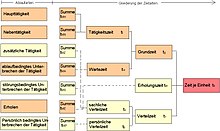Time type
Types of time incurred in the REFA method analysis and synthesis by the reassembly (synthesis) of the previously analyzed process types at times. The aim of the synthesis is to determine a standard time that can be used for different purposes. In principle, both the analysis of the process types and the synthesis of time types can be carried out, as appears appropriate for the present case. As for the analysis, REFA has also designed structures for the synthesis that prove themselves in most use cases and thus define standardized time types that are used in a large number of companies.
Importance of the types of time for humans
In the picture Outline of the types of time for humans , the possible types of times for humans and their structure are shown. In addition, the associated formula symbols of the REFA methodology are given. The times for the main activities to be performed and the secondary activities are summarized in the activity time. Together with the times for process-related interruptions ( waiting time ) that are inevitable in the work process , they form the basic time .
If the analysis has shown that a recovery time is necessary due to the continuous performance limit being exceeded , this is added to the time per unit .
The process types “additional activity”, “interruption due to disruption” form the factual distribution time , which, supplemented by the personal distribution time resulting from the personal interruption (going to the toilet, smoking break, etc.), form the distribution time . The distribution time is the third component of the time per unit.
Time types for the resource
As already done with the structure of the process types and can be seen in the picture Structure of the operating resource time , the time types for the operating resource are also structured in the same way as for humans. So the main use becomes the main use time and the secondary use becomes the secondary use time, both together to the activity time. Together with the waiting time derived from the process-related interruption of the equipment, the basic time, now that for the equipment, is formed again. The analogy extends to the distribution and recovery times, which do not arise from the equipment itself, but from the corresponding needs of the person using the equipment.
Definition of the default time
To determine the default times , the time types for people and resources are considered combined. In each case, the longer part of the time types associated with people and equipment as shown in the figure must be taken into account.
See also
swell
- ↑ REFA Association for Work Studies and Business Organization e. V. (Hrsg.): Methodology of work studies: Part 2 data determination . Darmstadt: REFA, 1978. - ISBN 3-446-12704-6 . Page p. 41–55


